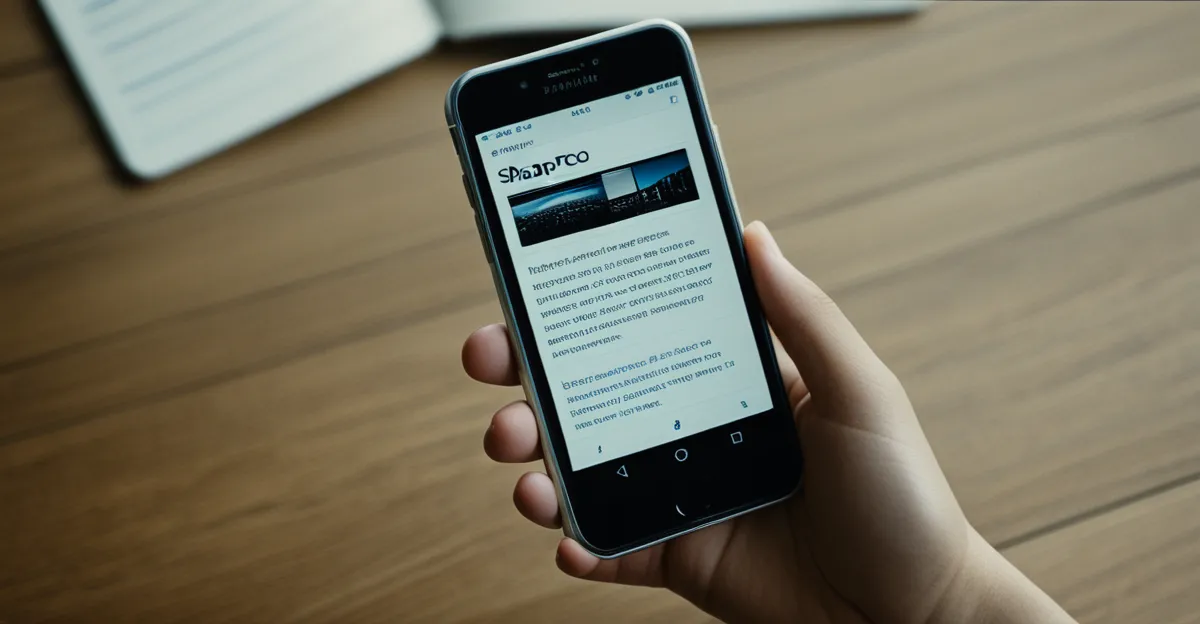Impact of Smartphones on Learning Experiences
Smartphones have significantly changed the landscape of education by enhancing learning experiences through their versatile capabilities. These handy devices have become a core part of modern educational strategies, primarily due to their ability to provide learning enhancement through various applications and features.
Statistics show that mobile devices increase engagement in educational settings by providing interactive tools that cater to different learning styles. For instance, educational apps and platforms accessible on smartphones have been shown to increase student participation and motivation by offering real-time feedback and personalized learning experiences. Additionally, features like notifications and interactive quizzes help keep students engaged, fostering a more dynamic learning experience.
In the same genre : How Do Smartphones Enhance Productivity in Modern Computing?
In classrooms, smartphones serve as powerful tools for both students and teachers. They support a wide range of educational formats, from virtual discussions to interactive simulations. Successful integration can be seen in training programs where smartphones are used to deliver content in bite-sized formats, promoting continuous and flexible learning anywhere at any time. Innovative solutions like augmented reality apps further enrich educational content, allowing students to visualize complex concepts easily.
Effective integration of smartphones in education not only enhances the way students interact with learning materials but also opens up new possibilities for smartphones in education. This transformation creates an engaging, adaptable, and more inclusive learning environment that can significantly benefit both learners and educators alike.
Topic to read : Sell your iphone 16 plus effortlessly with vendi's app
Accessibility and Inclusivity through Smartphones
Smartphones are redefining educational accessibility and fostering inclusive learning environments for all students. By leveraging the versatility of mobile technology, educators can address diverse needs and bridge educational gaps effectively.
Bridging the Gap for Underprivileged Students
Smartphones play a crucial role in leveling the playing field for underprivileged students. These devices offer access to a wealth of information and educational resources that might otherwise be out of reach. For instance, in regions with limited access to physical textbooks or educational facilities, smartphones serve as invaluable tools for learning. Various initiatives have focused on providing smartphones to students in remote areas, significantly widening their access to quality education and learning materials.
Customization for Diverse Learning Needs
One of the most compelling features of smartphones in education is their ability to cater to a wide range of learner profiles. Customizable apps allow students with different learning preferences and abilities to access content in formats that suit them best. For example, students with visual impairments can use voice-to-text features, while those with auditory processing difficulties might benefit from video content. By enabling this level of customization, smartphones ensure that learning experiences are inclusive and accessible to all.
Language and Translation Tools
Smartphones also facilitate communication and understanding across different languages, an essential aspect of inclusive education. With sophisticated language apps and translation tools, students can learn new languages or better understand content presented in foreign languages. These applications not only aid in language acquisition but also support students in developing communication skills essential in an increasingly globalized world. Schools have reported successful integration of such tools, resulting in enhanced interaction among students from diverse linguistic backgrounds.
Personalized Learning with Smartphones
Smartphones have revolutionized the way personalized education is delivered, thanks to adaptive learning technologies readily available through mobile interfaces. These innovations enable students to follow individualized learning paths, receiving real-time feedback tailored to their specific needs and progress. By using advanced algorithms, educational apps can adjust content difficulty and adapt teaching methods based on a learner’s performance, ensuring a more customized educational experience.
The benefits of gamification in smartphones cannot be overstated. Gamified elements, such as rewards, challenges, and interactive learning apps, significantly enhance student motivation. These features turn learning into an engaging experience that encourages perseverance and boosts overall academic achievement. Through smartphones, educators can leverage these tools to keep students captivated while imparting critical knowledge and skills.
Moreover, the integration of smartphones into education promotes adaptive learning environments where students can progress at their own pace. This customized approach not only addresses diverse learning needs but also ensures that each student can fully grasp subject matter before advancing. By fostering a supportive and engaging learning atmosphere, smartphones empower students to take charge of their educational journey, ultimately leading to more effective and satisfying learning outcomes.
Teaching Methodologies Enhanced by Smartphones
Smartphones have revolutionized innovative teaching strategies by facilitating diverse methods like the flipped classroom model and interactive assessments. This technological integration promotes more dynamic learning environments.
Flipped Classroom Model
The flipped classroom approach utilizes smartphones to deliver lecture content outside of class, thereby freeing up in-class time for interactive and practical exercises. This method maximizes the availability of instructional material and allows students to engage with content at their own pace. Video lectures and educational apps enhance learning by providing resources that are revisitable anytime, granting students control over their education.
Collaboration and Communication Tools
A vital advantage of smartphones is the support for collaboration and efficient communication between students and teachers. Tools such as collaborative documents and messaging apps facilitate real-time interaction and feedback. This connectivity breaks down barriers of physical distance and time, enabling students to work on group projects efficiently, no matter where they are situated.
Interactive Assessment Platforms
Smartphones also offer interactive assessment platforms that transform traditional testing methods. These platforms can deliver adaptive quizzes that adjust question difficulty based on student performance, providing timely feedback and enabling students to focus on areas needing improvement. Additionally, gamified assessments increase engagement, making the process of evaluation both educational and enjoyable.
By incorporating smartphones into educational practices, educators are better equipped to implement technology-integrated methodologies. Such enhancements not only cater to modern learning styles but also prepare students for a tech-driven future.
Case Studies: Successful Smartphone Integration in Education
Smartphones in education have proven immensely effective, as evidenced by various educational case studies. Schools and institutions embracing technology in learning have seen remarkable improvements in student engagement and outcomes, demonstrating the vast potential of smartphones as learning tools.
Enhanced Learning Environments
Institutions like Singapore’s Nanyang Technological University have successfully integrated smartphones into their curriculum, showcasing a shift towards more dynamic and technology-driven learning environments. Results from such implementations indicate that students benefit from increased access to educational resources, leading to improved understanding and retention of course material.
Moreover, schools that have strategically embedded smartphone usage in classrooms report enhanced collaboration among students. The use of collaborative apps allows for seamless sharing and discussion of information, which enhances peer-to-peer learning.
Measurable Improvements in Student Outcomes
Comparing traditional learning environments with those enhanced by smartphone technology reveals significant improvements in student outcomes. Notably, smartphone-integrated practices have led to higher levels of student motivation and participation.
Institutions such as the University of Southern California have documented improvements in test scores and overall academic performance when smartphones are effectively incorporated. These advancements are attributed to the interactive nature of smartphone apps that make learning more engaging.
Overcoming Challenges
Some case studies underline the importance of addressing potential challenges such as distractions in learning. Effective policies and structured implementation of smartphone usage can mitigate these drawbacks, ensuring focus remains on educational benefits.
Overall, these educational case studies affirm the positive impact of integrating smartphones in academic settings, not only transforming how students learn but also how educators teach. The ongoing evolution of smartphone technology continues to open new doors for enhancing educational experiences globally.
Best Practices for Integrating Smartphones in Education
Integrating smartphones in education effectively requires thoughtful planning and strategic implementation. By adopting best practices, educators can create a supportive learning environment that leverages mobile technology’s full potential.
Creating a Smartphone-Friendly Classroom Environment
Smartphone-friendly classrooms encourage students to utilise their devices as learning tools, not distractions. Establishing clear usage guidelines, such as allowing smartphones for specific activities and during designated times, helps maintain focus. It is essential for educators to model appropriate smartphone use, demonstrating how technology can enhance, rather than hinder, learning.
Training for Educators on Effective Technology Integration
Professional development is key to effective smartphone integration in education. Educators should be trained to identify and use applications that align with curriculum objectives, ensuring that technology supports academic goals. Training sessions could cover topics like adaptive learning tools and interactive apps, enabling teachers to integrate these technologies confidently and competently.
Involving Parents and the Community
Engaging parents and the wider community fosters a collaborative approach to smartphone use in education. Informational workshops can educate parents about the benefits of mobile learning and how they can support their children’s technology use. By championing transparency and inclusive dialogue, schools can build trust and promote a shared commitment to integrating smartphones in a manner that benefits all students.
By implementing these strategies, educators are better positioned to use smartphones as effective learning aids, creating a dynamic and responsive educational environment.
Challenges and Drawbacks of Smartphone Use in Education
Smartphones offer remarkable opportunities in education, but several challenges must be addressed for their effective integration. These smartphone challenges can impact the learning environment and need thoughtful consideration and management strategies.
Addressing Distractions and Off-Task Behavior
A common concern is that smartphones can lead to distractions in learning. When not monitored effectively, these devices can tempt students with non-educational activities like social media or gaming during class time. Educators have found success by implementing structured guidelines that specify when and how smartphones should be used. For example, designating specific times for device use during class helps maintain focus and ensures that smartphones only serve educational purposes.
Equity Issues in Smartphone Access
Equitable access to smartphones remains a pressing issue, as disparities in availability can exacerbate educational inequalities. Some students might not have access to these tools at home due to socioeconomic factors, highlighting the need for institutions to consider providing devices or alternatives to ensure that no students are left behind. Programs aiming to distribute smartphones or facilitate access to shared devices in schools can help achieve more educational accessibility and inclusivity.
Managing Screen Time and Usage Policies
The increasing reliance on smartphones in education requires careful management of screen time to prevent negative health effects like eye strain or reduced attention spans. Developing usage policies that balance screen time with traditional learning tools can help mitigate these concerns. Recommended strategies include incorporating regular breaks from screen use and promoting a diverse mix of learning activities to keep students engaged without over-reliance on digital screens. By implementing these solutions, educators can promote productive smartphone use while minimizing potential drawbacks.










